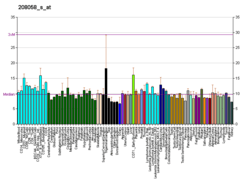MGAT3
Beta-1,4-mannosyl-glycoprotein 4-beta-N-acetylglucosaminyltransferase is an enzyme that in humans is encoded by the MGAT3 gene.[5][6]
There are believed to be over 100 different glycosyltransferases involved in the synthesis of protein-bound and lipid-bound oligosaccharides. The enzyme encoded by this gene transfers a GlcNAc residue to the beta-linked mannose of the trimannosyl core of N-linked oligosaccharides and produces a bisecting GlcNAc. Multiple alternatively spliced variants, encoding the same protein, have been identified.[6]
References
- 1 2 3 GRCh38: Ensembl release 89: ENSG00000128268 - Ensembl, May 2017
- 1 2 3 GRCm38: Ensembl release 89: ENSMUSG00000042428 - Ensembl, May 2017
- ↑ "Human PubMed Reference:".
- ↑ "Mouse PubMed Reference:".
- ↑ Ihara Y, Nishikawa A, Tohma T, Soejima H, Niikawa N, Taniguchi N (Oct 1993). "cDNA cloning, expression, and chromosomal localization of human N-acetylglucosaminyltransferase III (GnT-III)". J Biochem. 113 (6): 692–8. PMID 8370666.
- 1 2 "Entrez Gene: MGAT3 mannosyl (beta-1,4-)-glycoprotein beta-1,4-N-acetylglucosaminyltransferase".
Further reading
- Kim YJ, Park JH, Kim KS, et al. (1996). "Sequence analysis of the 5'-flanking region of the gene encoding human N-acetylglucosaminyltransferase III". Gene. 170 (2): 281–3. doi:10.1016/0378-1119(95)00818-7. PMID 8666260.
- Koyama N, Miyoshi E, Ihara Y, et al. (1996). "Human N-acetylglucosaminyltransferase III gene is transcribed from multiple promoters". Eur. J. Biochem. 238 (3): 853–61. doi:10.1111/j.1432-1033.1996.0853w.x. PMID 8706690.
- Bonaldo MF, Lennon G, Soares MB (1997). "Normalization and subtraction: two approaches to facilitate gene discovery". Genome Res. 6 (9): 791–806. doi:10.1101/gr.6.9.791. PMID 8889548.
- Dunham I, Shimizu N, Roe BA, et al. (1999). "The DNA sequence of human chromosome 22". Nature. 402 (6761): 489–95. doi:10.1038/990031. PMID 10591208.
- Ikeda Y, Koyota S, Ihara H, et al. (2000). "Kinetic basis for the donor nucleotide-sugar specificity of beta1, 4-N-acetylglucosaminyltransferase III". J. Biochem. 128 (4): 609–19. doi:10.1093/oxfordjournals.jbchem.a022793. PMID 11011143.
- Song EY, Kang SK, Lee YC, et al. (2002). "Expression of bisecting N-acetylglucosaminyltransferase-III in human hepatocarcinoma tissues, fetal liver tissues, and hepatoma cell lines of Hep3B and HepG2". Cancer Invest. 19 (8): 799–807. doi:10.1081/CNV-100107741. PMID 11768033.
- Shibukawa Y, Takahashi M, Laffont I, et al. (2003). "Down-regulation of hydrogen peroxide-induced PKC delta activation in N-acetylglucosaminyltransferase III-transfected HeLaS3 cells". J. Biol. Chem. 278 (5): 3197–203. doi:10.1074/jbc.M207870200. PMID 12427758.
- Strausberg RL, Feingold EA, Grouse LH, et al. (2003). "Generation and initial analysis of more than 15,000 full-length human and mouse cDNA sequences". Proc. Natl. Acad. Sci. U.S.A. 99 (26): 16899–903. doi:10.1073/pnas.242603899. PMC 139241. PMID 12477932.
- Sasai K, Ikeda Y, Ihara H, et al. (2003). "Caveolin-1 regulates the functional localization of N-acetylglucosaminyltransferase III within the golgi apparatus". J. Biol. Chem. 278 (28): 25295–301. doi:10.1074/jbc.M301913200. PMID 12716887.
- Millar JK, Christie S, Porteous DJ (2004). "Yeast two-hybrid screens implicate DISC1 in brain development and function". Biochem. Biophys. Res. Commun. 311 (4): 1019–25. doi:10.1016/j.bbrc.2003.10.101. PMID 14623284.
- Isaji T, Gu J, Nishiuchi R, et al. (2004). "Introduction of bisecting GlcNAc into integrin alpha5beta1 reduces ligand binding and down-regulates cell adhesion and cell migration". J. Biol. Chem. 279 (19): 19747–54. doi:10.1074/jbc.M311627200. PMID 14998999.
- Collins JE, Wright CL, Edwards CA, et al. (2005). "A genome annotation-driven approach to cloning the human ORFeome". Genome Biol. 5 (10): R84. doi:10.1186/gb-2004-5-10-r84. PMC 545604. PMID 15461802.
- Gerhard DS, Wagner L, Feingold EA, et al. (2004). "The status, quality, and expansion of the NIH full-length cDNA project: the Mammalian Gene Collection (MGC)". Genome Res. 14 (10B): 2121–7. doi:10.1101/gr.2596504. PMC 528928. PMID 15489334.
- Kimura K, Wakamatsu A, Suzuki Y, et al. (2006). "Diversification of transcriptional modulation: large-scale identification and characterization of putative alternative promoters of human genes". Genome Res. 16 (1): 55–65. doi:10.1101/gr.4039406. PMC 1356129. PMID 16344560.
- Fiala M, Liu PT, Espinosa-Jeffrey A, et al. (2007). "Innate immunity and transcription of MGAT-III and Toll-like receptors in Alzheimer's disease patients are improved by bisdemethoxycurcumin". Proc. Natl. Acad. Sci. U.S.A. 104 (31): 12849–54. doi:10.1073/pnas.0701267104. PMC 1937555. PMID 17652175.
This article is issued from
Wikipedia.
The text is licensed under Creative Commons - Attribution - Sharealike.
Additional terms may apply for the media files.




